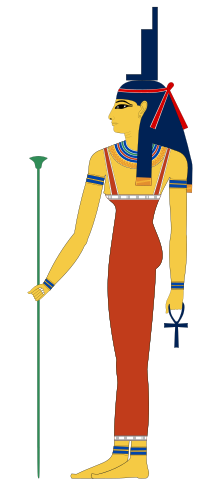

TYPE: Mother Goddess
ORIGIN: Egyptian
KNOWN PERIOD OF WORSHIP: Early dynastic period (circa 2700 BCE) and probably earlier until the end of Egyptian history (Circa CE 400)
CENTER(S) OF CULT: universal throughout areas of Egyptian influence, but particularly at Giza and at Behbeit el-Hagar in the Nile delta. Also at Thebes on the west bank, at Dendara and in the temple of Seti I at Abydos. A GrecoRoman sanctuary existed on Philae (now moved to Agilqiya).
ART REFERENCES: monumental carvings; contemporary sculptures; wall paintings and reliefs.
LITERARY SOURCES: Pyramid Texts; the Great Hymn to Isis from the stele of Amenemose (Louvre); etc.
INFORMATION: Isis is one of the great deities of the Egyptian pantheon and, with Osiris, probably maintained the most universal appeal outside Egypt. Greco-Roman culture was particularly enamored of her and called her Stella Maris (star of the sea), represented in the heavens by the north star. An offspring of Geb and Nut in the Heliopolis genealogy, Isis is the mother of the god kings of Egypt and both elder sister and consort of Osiris. The other siblings include Seth and Nephthys. Isis is depicted in human form, but usually wearing a crown in the form of a throne or cow horns encircling a sun disc (see Hathor). She may also be depicted, wholly or in part, as a hawk. From the New Kingdom (circa 1500 BCE) onward sheis also associated with a device not dissimilar to the ankh symbol and known as the "Isis knot". The symbol was incorporated into a bloodstone amulet known as the tyet.
In legend she is responsible twice for restoring Osiris, once after Seth has thrown his body into the Nile and again after Seth dismembered it. She impregnates herself from his corpse as he is entering the underworld as its ruler, and from Osiris's semen conceives Horus, to whom she gives birth in the papyrus swamps at Khemmis in the Nile delta. Thus, since Horus instilled himself into the king of Egypt during dile, and Osiris took over on death, (See also Horus and Osiris), the ruler was perceived to suckle at the breast of Isis (as Harpokrates). As Isis guarded Horus against injury, so she also protected the earthly king of Egypt as a child. In the courts of the gods, Isis put up a strong challenge in support of Horus's claim to the throne agains that of her brother Seth, and she showed Seth to be guilty of buggery against Horus.
In the Greco-Roman period, Isis sanctuaries were built on the Island of Delos and at Pompeii. There is much argument that the Isis cult influenced the portrayal of the Christian Virgin Mary, who was also known as Stella Maris and whose portraits with the Christ often bear a striking similarity to those of Isis with Horus.